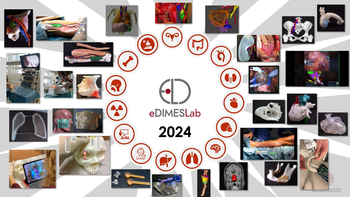Aims and Goals:
The eDIMES Lab is the DIMEC technological laboratory created as part of the Departmental Strategic Development Project (PSSD) to enhance advanced research and teaching activities in the areas of Medical Sciences and Biological Sciences, promoting their integration and synergy with the disciplines of Physical Sciences and Bioengineering.
The laboratory, making use of advanced methodologies and technologies such as Virtual Reality, Augmented Reality, Simulation, 3D Modeling, Additive Manufacturing, Computer Vision and Artificial Intelligence, aims to provide the medical areas within the IRCCS Azienda Ospedaliero-Universitaria di Bologna innovative tools for preoperative planning, for the design of personalized prosthetic devices, for intraoperative guidance and for diagnosis support.
The eDIMES Lab also promotes projects aimed at the development of innovative teaching models and tools, considering medical and surgical training a strategic factor for the development and maintenance of an advanced-level healthcare service based on quality and safety.
